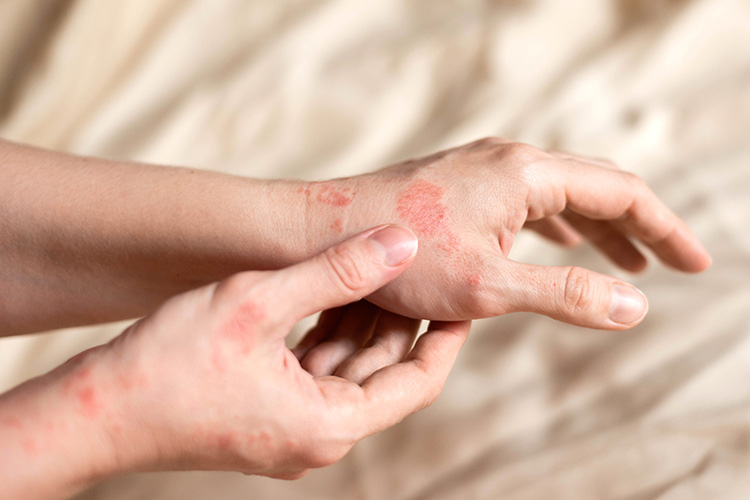Types of eczema

When we refer to eczema, we are typically referring to atopic dermatitis, the most common form of eczema, which is characterized by dry, itchy skin that can rash, crack, and bleed. You may also see the word dermatitis used to describe skin conditions. Dermatitis is just a generic term used to describe inflammation of the skin.
Did you know there are many types of dermatitis? In addition to the most common form of atopic dermatitis, there are three other common types: contact dermatitis, seborrheic dermatitis, and hand dermatitis.
To shed light on three types of dermatitis, Eczema Society of Canada (ESC) sought insights from Ottawa-based dermatologist Dr. Mark Kirchhof.
Contact Dermatitis
Contact dermatitis can be broken down into two types: allergic contact dermatitis (ACD) and irritant contact dermatitis (ICD), which is more common. ACD is caused by a delayed immune reaction, which causes a dermatitis flare triggered by contact with allergic substances such as perfumes, dyes, metals, or poison ivy. ICD results from repeated skin exposure to irritants like harsh soaps, cleaning products, and chemicals, damaging the skin’s protective layer and triggering inflammation.
Dr. Kirchhof simplifies contact dermatitis, explaining, “Contact dermatitis occurs when certain chemicals contact the skin and causes a dermatitis or inflammation. For example, we often see hairstylists, whose chemicals they’re using in their work, go on to develop dermatitis of the hands. Other common triggers may include detergents, shampoos, make-up, rubber products, and nickel.”
Seborrheic dermatitis
Seborrheic dermatitis, also commonly known as dandruff when on the scalp, is characterized by flaking of the skin combined with yellow crusting in patches. This condition can be very itchy, impacting the scalp and extending to the face, nose, eyebrows, ears, and chest. This condition can occur in adults but can also present as cradle cap for infants.
Dr. Kirchhof explains the link to sebum, an oil produced on the skin: “Sebum is food for a fungus on the skin. Some people produce more sebum, which increases fungus and causes irritation and inflammation.” Seborrheic dermatitis is typically found on the skin in hair-bearing areas or places where you produce lots of sebum.”
Hand dermatitis
Hand dermatitis is a common type of eczema that develops on the hands, causing itchy, dry, scaly skin prone to cracking and flaking. Often job-related, it can also result from daily activities like frequent hand washing and exposure to harsh chemicals.
Dr. Kirchhof tells us, “Hand dermatitis can be particularly difficult to treat as it can often be related to people’s profession and environmental exposures. The location of the dermatitis on the hands can provide insights into potential causes.”
The good news is that no matter what type of dermatitis you are suffering with, there is help. Dr. Kirchhof tells us, “A certified dermatologist can help patients manage their dermatitis and navigate treatment options that are available.”
The Eczema Society of Canada thanks Dr. Mark Kirchhof, MD, PhD, FRCPC, FAAD, for his volunteer contribution to this educational content.
Disclaimer: Information provided in this resource does not constitute medical advice and is not intended to be used as a diagnostic tool. The information is up-to-date at time of publication. All medications, interventions, and treatment plans have risks and benefits, and it is important that individuals discuss their or their child’s specific health care needs with a qualified health care professional.
December 2023



